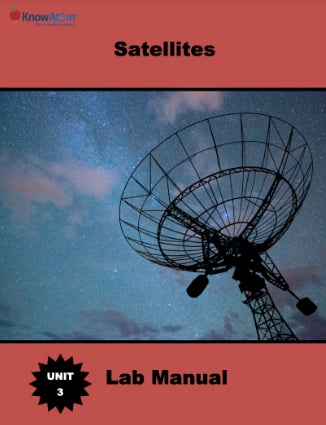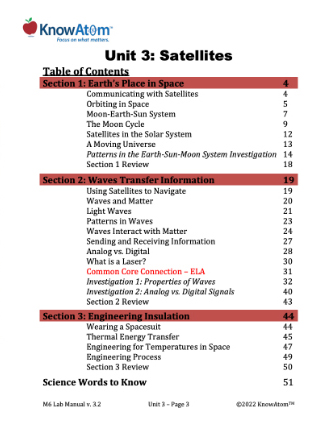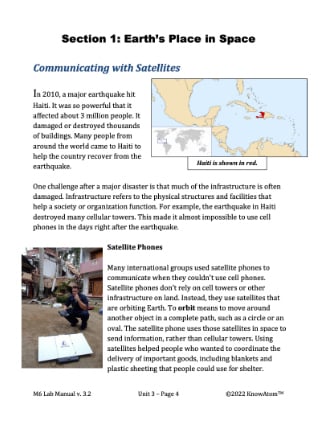The science background section provides teachers with more in-depth information on the phenomena students explore in this unit. Here is an excerpt from this section on engineering thermal control.
Engineers Design Solutions
All forms of technology are designed by engineers. Engineers use that scientific knowledge and mathematics to solve problems by creating new technologies. A technology is not just a computer or electronic device. Instead, it is anything that people have modified from the natural world to meet their needs and wants. Any satellite created by people to solve a problem is a technology designed by engineers.
Similar to how scientists follow a process to answer a question, engineers also follow a process. Engineers often follow a set of eight steps as they create new technologies to solve problems. The engineering process is similar to the scientific process but it differs because each has a different goal. Scientists are trying to answer a question, while engineers are trying to solve a problem. The engineering process begins with a problem. When engineers are defining a problem, they include the criteria (the needs the solution must meet) and constraints (ways the solution is limited). For example, engineers designed the spacesuit that astronauts wear while in space. The most important problem this technology solved was how to keep astronauts safe in the harsh space environment.
An astronaut’s spacesuit is very complex, with many different parts. It is actually a personalized spacecraft, designed to protect the astronaut. There are many reasons astronauts need to wear spacesuits. For example, there is no atmosphere in space, which means there is no oxygen for people to breathe. Oxygen is essential for life, so the spacesuit has an oxygen tank built into it. The spacesuit also has a radio, earphones, and microphones so the astronaut can talk to other astronauts back onboard the space station.
Designing Insulating Technology
In the example of the spacesuit, the criteria might be that the materials have to be able to withstand the extreme heat and cold of space. When outside of a spacecraft, the side of the astronaut facing the sun may be heated to temperatures as high as 121 degrees Celsius (250 degrees Fahrenheit). The side of the astronaut facing away from the sun may reach temperatures as low as -156 degrees Celsius (-250 degrees Fahrenheit).
Available materials and cost are two common engineering constraints. However, engineers designing suits for astronauts are less worried about cost than many engineers because safety is the primary concern. According to some estimates, one spacesuit costs about 2 million dollars.
Once they have identified the problem, engineers need to research it to find out what is known about the problem. In our example, engineers would need to know about heat transfer, how the sun’s energy transfers heat through radiation, and that certain materials are more reflective than others, while others are more absorbent, turning the sun’s energy into heat. Some materials are also good thermal conductors. This means they easily let heat pass through them. Metals are good thermal conductors. Materials that are good thermal insulators do not easily let heat pass through them. Plastics and foams are good thermal insulators.
Creating a Prototype
Before engineers begin designing a solution, they survey the available materials. This survey includes a sketch of the material, as well as how much of the material they have available and the properties of that material.
Engineers then come up with possible solutions for how the problem can be solved with the available materials. For example, engineers designing spacesuits would decide which materials they want to use and how they want to combine the materials in a way that is most insulating.
For example, they might decide on making the outer layer of the space suit white and reflective so energy from the sun isn’t absorbed by the suit. They might also decide to add a layer that doesn’t release heat quickly, which will help the suit maintain its internal temperature.
The next step in the engineering process is to diagram and build a prototype. A prototype is a scaled-down first draft of a technology. Once built, engineers test the prototype. They use the tests to gather data about how well the prototype solves the problem during testing.
Finally, engineers use their data to decide whether to refine or replicate. The data tell engineers whether their prototype technology solved the problem. Engineers designing a spacesuit would want to test how well their prototype maintained a specified temperature.








